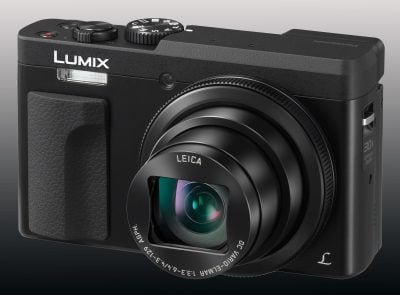Panasonic Lumix TZ90 / ZS70 review
-
-
Written by Ken McMahon
Quality
To test real-life performance, I shot this scene with the Panasonic Lumix TZ90 / ZS70 and the Canon PowerShot SX730 HS using their best quality JPEG settings and at their base 80 ISO sensitivity setting. Both cameras were mounted on a tripod and image stabilisation was disabled, the sensitivity was manually set to 80 ISO and Aperture priority mode was selected for the exposure. I set the Aperture to f3.3 which I’d previously determined produced best results and both cameras selected a shutter speed of 1/1250.
The TZ80 / ZS60 has optional diffraction compensation which attempts to correct for the reduction in image quality caused by light diffraction at small aperture sizes. Diffraction compensation is turned off by default and so that’s where I left it for these quality tests.
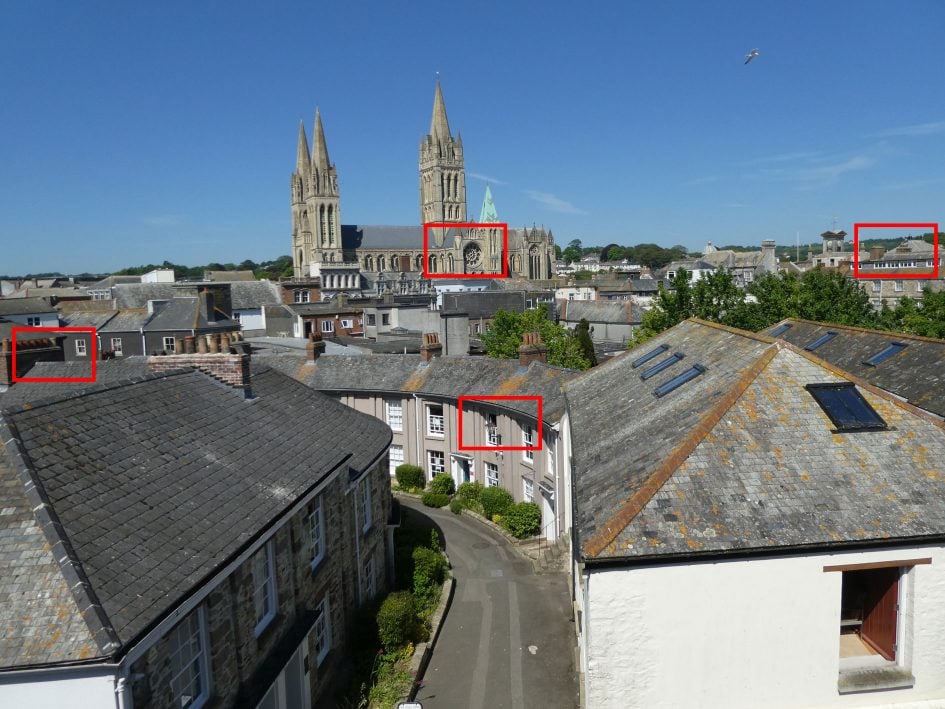
As usual, the crops below are taken from the areas marked in red above. For this test both cameras were set to their maximum wide angle setting of 24mm, scroll down the page to see more results with the lenses zoomed in.
Both the Lumix TZ90 / ZS70 and the PowerShot SX730 HS have a 20 Megapixel sensor that produces 4:3 proportioned images 5184×3888 pixels in size, so these crops are identical in terms of the area and the size of the detail. Looking at the first crop below, from close to the left edge of the frame, the difference is pretty striking; the crop from the Lumix TZ90 / ZS70 on the left is quite soft and lacking in detail, plus there’s a little bit of colour fringing around the window frame (it would probably be more visible if it weren’t for the softness). Despite the softness there’s also some evidence of noise in this first crop, with shadow detail looking a little clumpy.
Moving down the left column, things improve considerably with the next two crops which are from the middle of the frame. In the second crop there’s a good level of detail in the cathedral stonework, but the noise is still taking the sharpness off the edges. And in the third crop, the edges of the roof tiles aren’t as crisply defined as they could be.
Finally, the fourth crop from close to the right edge of the frame sees a return to the softness and mild chromatic aberration we saw in crop one from the opposite edge. Although I’ve been quite critical, overall this isn’t a bad set of results from the Lumix TZ90 / ZS70. The overall level of detail is good and the TZ90 / ZS70 produces sharp results, away from the frame edges at least. I’d sum it up by saying its a good result that would have been a lot better but for lack of edge sharpness from the lens and noise from the sensor.
By comparison, the Canon PowerShot SX730 HS turns in a much better set of results at this focal length. The difference in the first crop is quite dramatic; it’s sharper, more detailed, less noisy and doesn’t suffer from colour fringing. The same is true of the next two crops from the middle of the frame, to a lesser degree because the Lumix ups its game here. And the final crop from the SX730 HS, from the right frame edge, is again sharper and more detailed then the one from the Lumix TZ90 / ZS70. Scroll down to see how these two models compare when zoomed in to around 150mm.

Above left: Panasonic Lumix TZ90 / ZS70 at 4.3mm (24mm equivalent) f3.3, 80 ISO.
Above right: Canon PowerShot SX730 HS at 4.3mm (24mm equivalent) f3.3 80 ISO

Above left: Panasonic Lumix TZ90 / ZS70 at 4.3mm (24mm equivalent) f3.3, 80 ISO.
Above right: Canon PowerShot SX730 HS at 4.3mm (24mm equivalent) f3.3 80 ISO

Above left: Panasonic Lumix TZ90 / ZS70 at 4.3mm (24mm equivalent) f3.3, 80 ISO.
Above right: Canon PowerShot SX730 HS at 4.3mm (24mm equivalent) f3.3 80 ISO

Above left: Panasonic Lumix TZ90 / ZS70 at 4.3mm (24mm equivalent) f3.3, 80 ISO.
Above right: Canon PowerShot SX730 HS at 4.3mm (24mm equivalent) f3.3 80 ISO
Panasonic Lumix TZ90 / ZS70 quality at 151mm equivalent
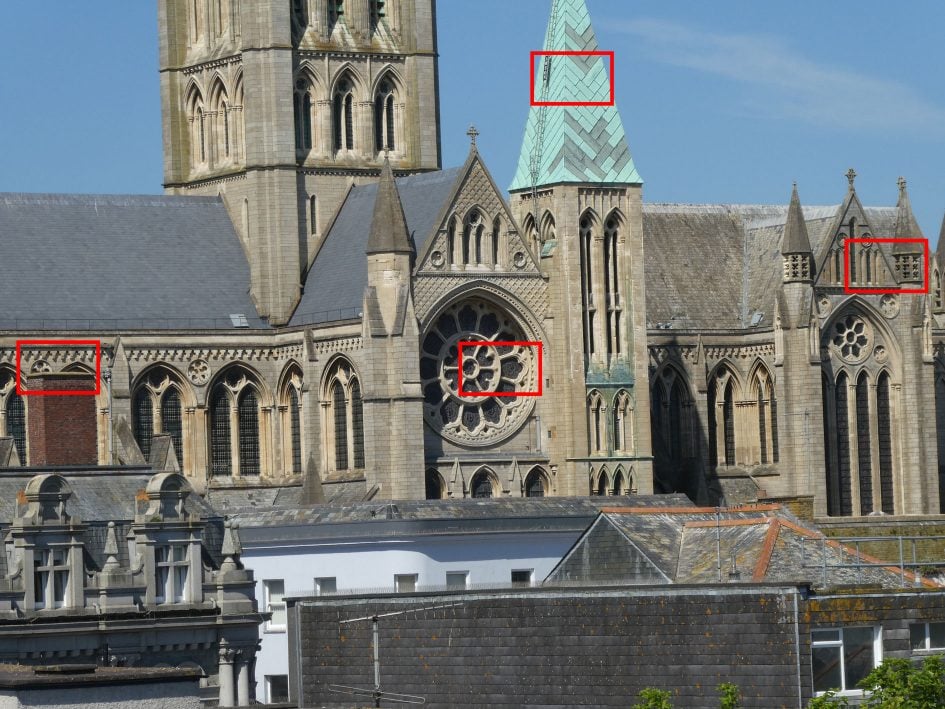
Here I’ve zoomed both models in to an equivalent focal length of 151mm. What’s interesting here is that the softness at the edge of the frame that we saw earlier on the Lumix TZ90 / ZS70 has all but disappeared. With the lens zoomed in to 151mm equivalent the first crop from the left edge of the frame is much cleaner, sharper and more detailed than it was at 24mm. At this focal length the Lumix TZ90 / ZS70 produces a much more consistent set of results which overall I’d say just outdoes the Canon PowerShot SX730 HS. The first and second crops from the Lumix are just a little bit sharper than the Canon’s, on the third crop it’s too close to call and in crop 4 the Lumix has the edge again. That makes it 1-all. Scroll down for the decider at the Lumix TZ90 / ZS70’s maximum 720mm zoom.

Above left: Panasonic Lumix TZ90 / ZS70 at 27.1mm (151mm equivalent) f5.4, 80 ISO.
Above right: Canon PowerShot SX730 HS at 27.1mm (151mm equivalent) f5.6 80 ISO
Above left: Panasonic Lumix TZ90 / ZS70 at 27.1mm (151mm equivalent) f5.4, 80 ISO.
Above right: Canon PowerShot SX730 HS at 27.1mm (151mm equivalent) f5.6 80 ISO

Above left: Panasonic Lumix TZ90 / ZS70 at 27.1mm (151mm equivalent) f5.4, 80 ISO.
Above right: Canon PowerShot SX730 HS at 27.1mm (151mm equivalent) f5.6 80 ISO

Above left: Panasonic Lumix TZ90 / ZS70 at 27.1mm (151mm equivalent) f5.4, 80 ISO.
Above right: Canon PowerShot SX730 HS at 27.1mm (151mm equivalent) f5.6 80 ISO
Panasonic Lumix TZ90 / ZS70 quality at 720mm equivalent
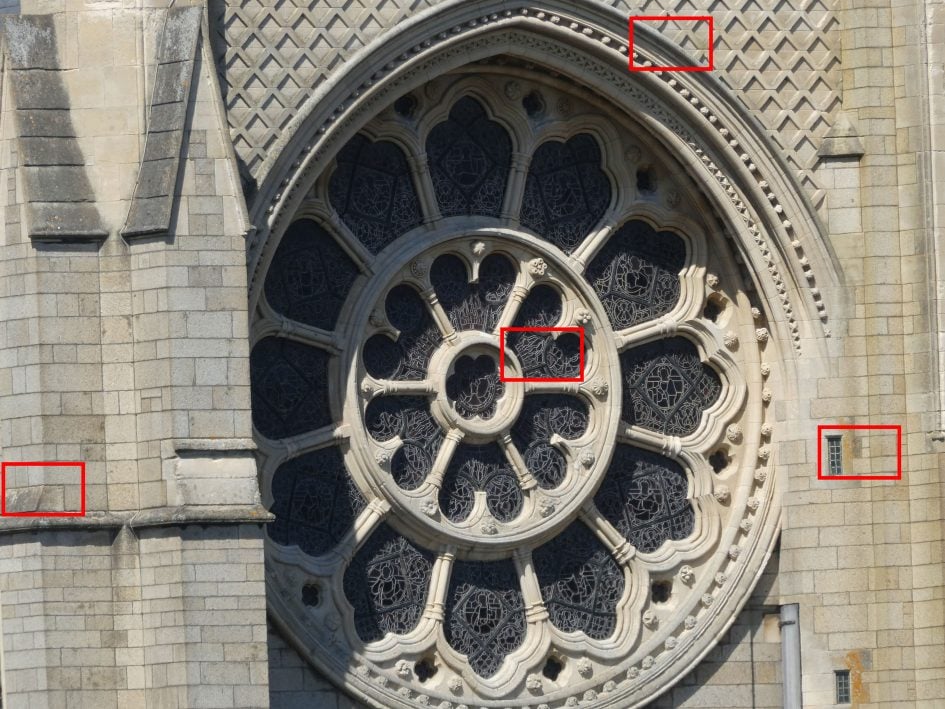
For this final set of crops I zoomed the Lumix TZ90 / ZS70 to its maximum 720mm zoom position and zoomed the PowerShot SX730 HS in to match the field of view. Don’t forget the SX730 HS’s 40x zoom can go further than this – to an equivalent 960mm. This is again an interesting set of results; it seems the further you zoom the Lumix TZ90 / ZS70, the better it gets. This is the best of the three sets of crops produced by the TZ90 / ZS70 with good detail and sharp edges across the frame from edge-to-edge. The lens is performing much better at the maximum focal length than it did at either the 24mm wide angle or, to a lesser degree, zoomed in to 151mm. You can still make out the noise from the sensor – it’s most obvious in the shadows of the stonework in the second crop, but this is nonetheless a great performance from the Lumix TZ90 / ZS70.
By comparison, the PowerShot SX730 HS crops are good, but generally softer than those from the TZ90 / ZS70. They’re also prone to colour fringing, which is particularly visible in the second crop. This is pretty much a reversal of what we saw at the 24mm wide angle setting so, on balance, I think you’d have to call it a draw, with the PowerShot SX730 HS winning at the wide-angle setting, the Lumix TZ90 / ZS70 at its maximum 720mm zoom, and a similar level of performance in the middle.

Above left: Panasonic Lumix TZ90 / ZS70 at 129mm (720mm equivalent) f6.4, 80 ISO.
Above right: Canon PowerShot SX730 HS at 131mm (731mm equivalent) f6.3 80 ISO

Above left: Panasonic Lumix TZ90 / ZS70 at 129mm (720mm equivalent) f6.4, 80 ISO.
Above right: Canon PowerShot SX730 HS at 131mm (731mm equivalent) f6.3 80 ISO

Above left: Panasonic Lumix TZ90 / ZS70 at 129mm (720mm equivalent) f6.4, 80 ISO.
Above right: Canon PowerShot SX730 HS at 131mm (731mm equivalent) f6.3 80 ISO

Above left: Panasonic Lumix TZ90 / ZS70 at 129mm (720mm equivalent) f6.4, 80 ISO.
Above right: Canon PowerShot SX730 HS at 131mm (731mm equivalent) f6.3 80 ISO
Panasonic Lumix TZ90 / ZS70 JPEG Noise
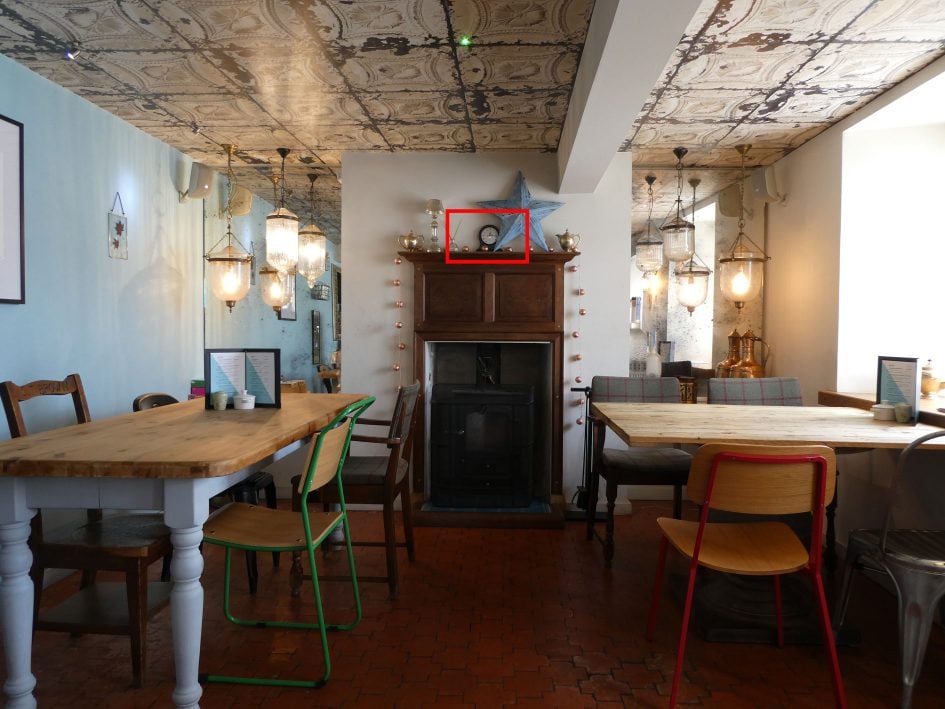
To examine noise levels under real-life conditions, I shot this scene with Panasonic Lumix TZ90 / ZS70 and the Canon PowerShot SX730 HS at each of their ISO sensitivities using their highest quality JPEG settings. Both cameras were mounted on a tripod and stabilisation was disabled.
The cameras were set to their maximum wide angle 24mm equivalent view. The ISO sensitivity was manually set to the lowest available setting and Aperture priority mode was selected for the exposure. I’d previously determined that best results were obtained at f3.3 so both cameras were set to f3.3 and at its base 80 ISO sensitivity setting the Lumix TZ90 / ZS70 selected a shutter speed of 1/5. I applied -1/3EV exposure compensation on the PowerShot SX730 HS to achieve a close to equivalent exposure of 1/6.
As usual the crops below are taken from the area marked in red above. Looking at the first crop on the left below, it’s clear that the Lumix TZ90 / ZS70 suffers from visible noise at its base 80 ISO setting. If you’ve looked at my outdoor quality tests above you’ll already be aware of that. The PowerShot SX730 HS, which like the Lumix TZ90 / ZS70 has a 20 Megapixel sensor is also a little noisy at its base 80 ISO sensitivity setting as you can see from the crop on the right. But the Canon’s noise is somehow less intrusive. It has a uniformly fine-grained appearance which is less disruptive of fine detail than the clumpy noise produced by the Lumix sensor.
Moving down to the 100 ISO crop, the noise is visibly worse here, so for the best image quality it makes sense to leave the TZ90 / ZS70 on its base 80 ISO setting whenever possible. At each step up the sensitivity scale, the noise increases, pretty much linearly, I’d say you could expect to produce good quality 100 percent prints (about 25×20 inches) or view on a big screen without noticing the quality loss too much up to and including 400 ISO. Of course at smaller sizes – on a phone or tablet, or even a laptop – you’ve got more leeway and 800 or even 1600 ISO will look good. It’s at 1600 ISO though that things really begin to go South, with the noise gaining the upper hand over image detail.
3200 ISO is good to have for those ‘must have at any cost’ shots – the christenings in gloomy churches, or night shots where you don’t want to, or can’t use flash. Given the big hike in noise between 3200 and 6400, just underexposing by a stop might yield better results. Don’t forget you can only access 6400 ISO by unlocking Extended ISO from the menu.
As at 80 ISO, the difference between the Lumix TZ90 / ZS70 and PowerShot SX730 HS throughout the sensitivity range – all the way up to the Canon’s maximum 3200 ISO – is that the latter’s noise is qualitatively different. The uniform fine grain interferes less with image detail and produces, in my opinion a much better result.

Above left: Panasonic Lumix TZ90 / ZS70 at 80 ISO f3.3. Above right: Canon PowerShot SX730 HS at 80 ISO f3.3.

Above left: Panasonic Lumix TZ90 / ZS70 at 100 ISO f3.3. Above right: Canon PowerShot SX730 HS at 100 ISO f3.3.

Above left: Panasonic Lumix TZ90 / ZS70 at 200 ISO f3.3. Above right: Canon PowerShot SX730 HS at 200 ISO f3.3.

Above left: Panasonic Lumix TZ90 / ZS70 at 400 ISO f3.3. Above right: Canon PowerShot SX730 HS at 400 ISO f3.3.

Above left: Panasonic Lumix TZ90 / ZS70 at 800 ISO f3.3. Above right: Canon PowerShot SX730 HS at 800 ISO f3.3.

Above left: Panasonic Lumix TZ90 / ZS70 at 1600 ISO f3.3. Above right: Canon PowerShot SX730 HS at 1600 ISO f3.3.

Above left: Panasonic Lumix TZ90 / ZS70 at 3200 ISO f3.3. Above right: Canon PowerShot SX730 HS at 3200 ISO f3.3.

Above left: Panasonic Lumix TZ90 / ZS70 at 6400 ISO f3.3.




